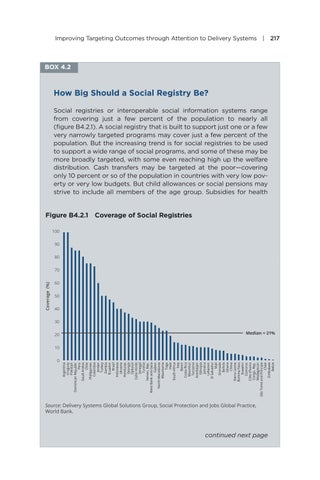Improving Targeting Outcomes through Attention to Delivery Systems | 217
BOX 4 .2
How Big Should a Social Registry Be? Social registries or interoperable social information systems range from covering just a few percent of the population to nearly all (figure B4.2.1). A social registry that is built to support just one or a few very narrowly targeted programs may cover just a few percent of the population. But the increasing trend is for social registries to be used to support a wide range of social programs, and some of these may be more broadly targeted, with some even reaching high up the welfare distribution. Cash transfers may be targeted at the poor—covering only 10 percent or so of the population in countries with very low poverty or very low budgets. But child allowances or social pensions may strive to include all members of the age group. Subsidies for health
Figure B4.2.1 Coverage of Social Registries 100 90 80
Coverage (%)
70 60 50 40 30 20
Median = 21%
0
Argentina Uruguay Pakistan Dominican Republic Peru Saudi Arabia Chile Phillippines Colombia Jordan Turkey Zambia Ecuador Brazil Indonesia Ukraine Honduras Georgia Djibouti Cabo Verde Senegal Tunisia Yemen, Rep. West Bank and Gaza Gabon North Macedonia Mauritania Togo Haiti South Africa Iraq Benin Costa Rica Mauritius Tanzania Azerbaijan Ethiopia Jamaica Lebanon El Salvador Mali Grenada Bolivia Ghana China Sierra Leone Burkina Faso Eswatini Comoros Côte d’Ivoire Congo, Rep. Madagascar São Tomé and Príncipe Chad Zimbabwe Belize
10
Source: Delivery Systems Global Solutions Group, Social Protection and Jobs Global Practice, World Bank.
continued next page


